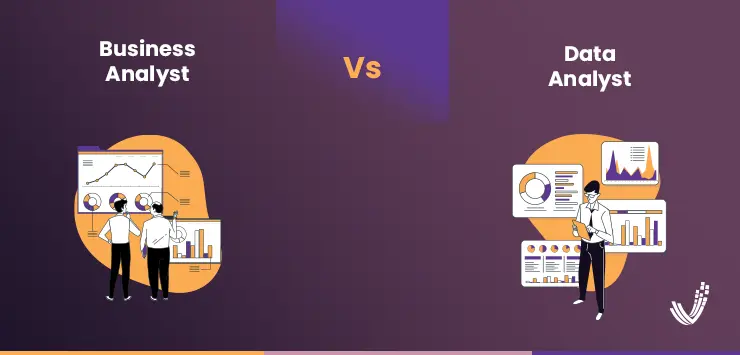Data Analysts and Business Analysts are the twin engines propelling data-inspired decisions in modern organizations.
Think of Data Analysts as the data whisperers, immersing themselves in numbers and patterns, while Business Analysts act like business doctors, diagnosing problems and prescribing solutions.

Both roles are highly regarded in the professional sphere, often attracting significant interest and typically associated with competitive remuneration.
In today’s blog, we’ll dive deep into the world of data and how business and data analyst roles differ when it comes to working with data.
Business and Data Analytics Uncovered: A Swift Overview
In the grand tapestry of the business world, business analytics and data analytics are both essential threads, each intricately woven with data, drawing insights from it and using this knowledge to amplify business performance.
So, what sets these two apart on the stage of analytics?
Business analytics can be compared to the master weaver, focusing on the broader design of the tapestry – the significant business complications of data and the resulting actions, such as deciding whether a company should weave a new product line into its offering or prioritize one project over another. Business data analysis is essentially a blend of skills, tools, and applications that empower businesses to gauge and enhance the effectiveness of their core functions like marketing, customer service, sales, or IT.
On the other side, data analytics is akin to the meticulous thread-picker, methodically going through massive datasets, unearthing patterns and trends, and drawing conclusions to validate hypotheses and support business decisions with data-driven insights. Data analytics seeks to answer questions like, “How do geography or seasonal factors color customer preferences?” or “What’s the probability a customer will switch loyalties to a competitor?”. This practice is a rich domain, encompassing multiple techniques and approaches, often referred differently, including big data analytics, data mining, data science, or data modeling.
Comparing Roles of Data Analysts & Business Analysts
What Do Data Analysts Do?
A data analyst is similar to a maestro, orchestrating a symphony of data. They gather, refine, analyze, visualize, and narrate the story of existing data to guide business decisions. An accomplished data analyst uses this numerical symphony to answer crucial questions and empower decision-makers to chart the best route forward. The dance of a data analyst typically involves:
- Engaging with business leaders and stakeholders to outline a problem or business necessity
- Detecting and sourcing the raw material – the data
- Refining this raw material by cleaning and preparing it for analysis
- Scrutinizing the data for patterns and trends, akin to a conductor listening for the harmonies within a symphony
- Visualizing the data in a manner that makes it as comprehensible as a well-written musical score
- Presenting the data in such a way that it weaves a compelling narrative, much like a captivating symphony
What Do Business Analysts Do?
Business analysts are the navigators of an organization’s seascape. They help pinpoint problems, opportunities, and solutions for their respective organizations. Their compass and map involve:
- Assessing a company’s current functions and IT structures, much like evaluating the wind and waves before setting sail
- Reviewing processes and interviewing team members to identify potential course corrections or improvements
- Presenting their findings and recommendations to the captain and crew (management and other key stakeholders)
- Creating visuals and financial models as navigation aids to support business decisions
- Training and coaching the crew (staff) in new systems, ensuring everyone is ready to navigate the new course effectively
You might be interested in: Cloud Data Warehousing
Must-Have Skills & Secret to Success in Data & Business Analyst Roles
Business and data analysts need more than just technical know-how to truly excel. Here’s what they do to be successful in their job and deliver ideal outcomes for employers or clients.
A data analyst can be instrumental in a client’s success by honing these capabilities:
- Their ability to convert raw data into valuable business insights can unveil opportunities and drive strategic decision-making.
- Being self-reliant, they can efficiently solve problems and make crucial decisions, reducing client’s time and effort.
- Their knack for identifying pertinent data sets and integrating them swiftly ensures the analysis remains relevant and timely.
- They communicate results in an understandable and impactful way, turning complex data into easy-to-digest information for the client.
- Their skill to devise new data collection and analysis processes as needed means they can adapt to the client’s changing needs, keeping them ahead of the curve.
A business analyst can be a game changer for clients by mastering the following:
- Embracing a holistic approach to business issues or challenges, they can spot opportunities where others see obstacles.
- By collaborating with members throughout the organization, they gather essential information that fuels transformation – turning problems into solutions for the client.
- They create clear, easily digestible business and project plans, reports, and analyses – providing a roadmap for success.
- Their engagement and open communication with stakeholders at all organizational levels ensures everyone is on board with the client’s vision.
- Their ability to articulate recommendations compellingly for diverse audiences means the client’s message is heard, understood, and acted upon.
The Significance of Modern Data Roles
Every venture, from fresh startups to seasoned global giants, needs to ride the data wave. Be it business analytics or data analytics, both are simply different routes to the same destination – using data as a catalyst for innovation and growth.
The key to this journey? Gathering credible data swiftly, seamlessly, and safely. That’s where experienced data companies, such as Veraqor, step in.
So, as businesses navigate the complex terrain of data usage, having an experienced partner to take care of your data can make the journey not just manageable but genuinely transformative – and lead towards actual digital transformation.
Takeaway
To conclude, we can safely say that the roles of a Business Analyst and a Data Analyst, while distinct, are both integral cogs in the data-driven machinery of modern businesses. And with the increased reliance on data to make decisions, the significance has increased. They’re like two sides of the same coin, each bringing a unique perspective.
A Business Analyst translates data into actionable strategies, while a Data Analyst digs deep into numbers to unearth insights. It’s this synergy that makes them so crucial in the data-centric landscape.
So, whether you’re a growing startup or an established enterprise, remember: it’s not about choosing between business analytics and data analytics – it’s about fusing them together to ride the wave of data-driven growth and innovation and, eventually, toward digital transformation.




